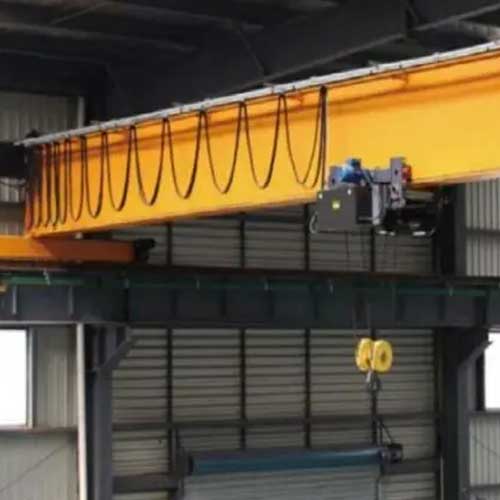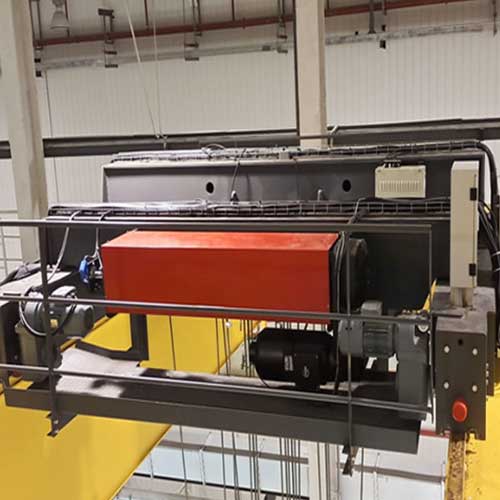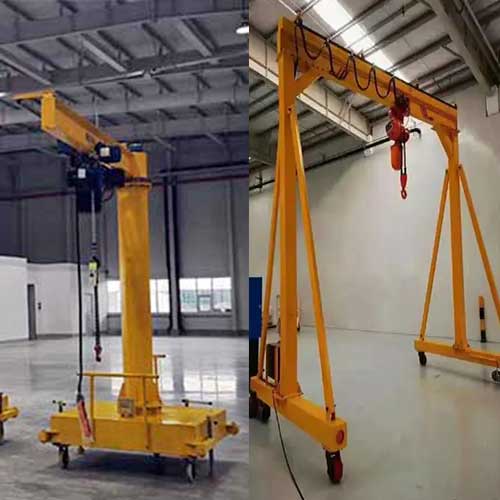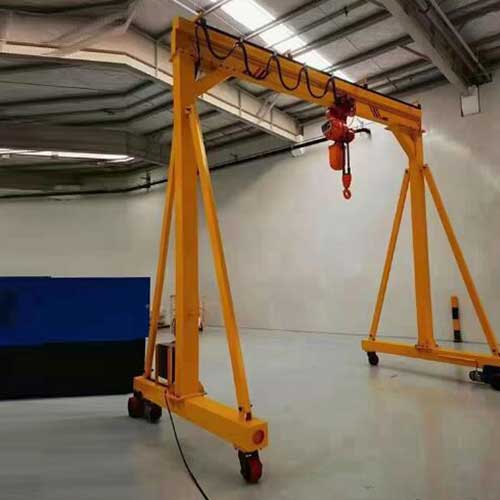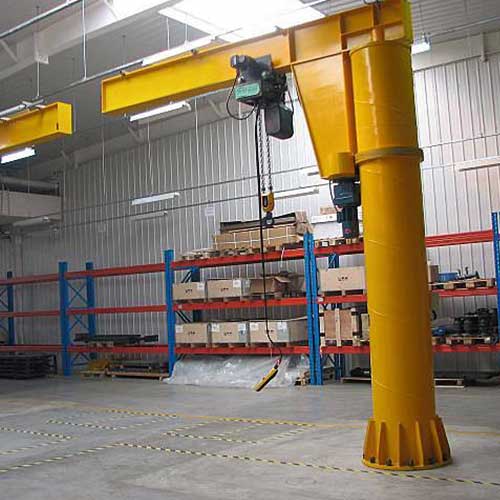Electric Cranes & Electric Hoists: Types, Power Supply, Safety & Maintenance
Electric Cranes & Electric Hoists: Types, Power Supply, Safety & Maintenance . Check 110V, 220V, 230V, 380V, 400 V and 440V electric cranes & electric hoists.
Category: Overhead Hoist
Your Trusted Electric Crane and Electric Hoist Manufacturer & Supplier
Electric Cranes and Electric Hoists Overview
Electric Cranes and Hoists Types, Power Supply, Safety & Maintenance
Electric overhead cranes and hoists play a pivotal role in various industries, revolutionizing the way heavy loads are handled and moved within manufacturing plants, construction sites, warehouses, and more. These powerful machines are essential for lifting, transporting, and positioning substantial loads with precision and efficiency.
At the heart of their functionality lies a crucial element often overlooked: the power supply voltages. The voltage requirements of electric cranes and hoists are fundamental aspects that significantly influence their performance, safety, and compatibility with specific operational environments.
Understanding the Importance of Power Supply Voltages
Voltage considerations are paramount in the world of electric overhead cranes and hoists. These machines rely on electrical power to operate their lifting mechanisms, traverse motions, and control systems. Understanding the voltage requirements and ensuring compatibility with the power supply available at the site of operation is critical to their safe and effective functioning.
Different regions around the globe adopt varying voltage standards, which significantly impacts the design and specifications of these machines. Voltage variations like 110V, 220V, 230V, 380V, 400 V and 440V are prevalent in different parts of the world, and selecting the appropriate voltage for a specific crane or hoist depends on various factors, including load capacity, operational environment, and local electrical standards.
The voltage requirements not only dictate the type of electrical components used but also affect the performance, efficiency, and safety of the entire system. An accurate understanding of these requirements ensures seamless integration into existing power systems, preventing potential hazards and operational issues down the line.
Types of Electric Cranes and Hoists
Electric Cranes and Hoists Classification based on Mechanism:
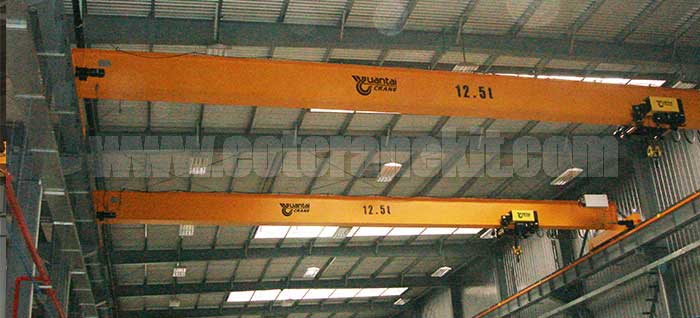
Electric Wire Rope Hoists/Cranes:
- Utilize wire ropes wound around a drum for lifting and lowering heavy loads.
- Suitable for applications requiring high load capacities and durability.
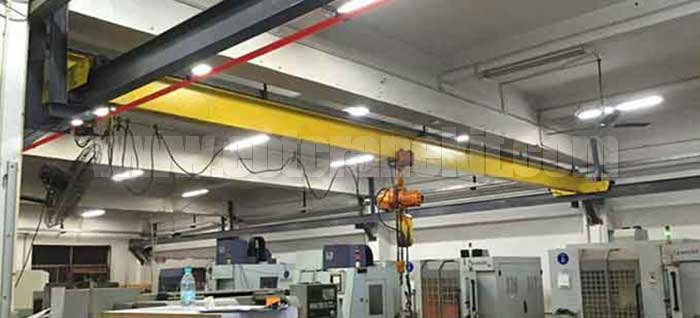
- Operate using a chain mechanism for lifting and lowering loads.
- Suitable for lighter to moderate loads in various industrial and commercial settings.
Electric Cranes and Hoists Classification based on Mounting:

Overhead Electric Hoists/Cranes: Single Girder & Double Girder Design , Top Running & Underhung Crane Design
- Mounted on tracks attached to the ceiling or framework above the workspace.
- Includes bridge, gantry, or jib cranes for lifting and moving loads.

Gantry Electric Hoists/Cranes: Single Girder & Double Girder, Semi Gantry & A frame Gantry Hoist
- Supported by legs or wheels running on rails on the ground.
- Offers portability and flexibility for lifting heavy loads in different locations.
Classification based on Control:
- Pendant-Control Electric Hoists/Cranes:- Controlled by a pendant or control pendant for manual lifting operations.
- Remote-Control Electric Hoists/Cranes:- Equipped with remote control devices for distant operation, enhancing safety and convenience.
Classification based on Usage:
- Light-Duty Electric Hoists/Cranes:- Designed for lighter loads and smaller-scale lifting applications.
- Heavy-Duty Electric Hoists/Cranes:- Engineered for lifting heavier loads and demanding industrial applications.
Classification based on Power Source:
Single Phase Electric Hoists/Cranes:
- Operate using a single-phase power supply (typically 110V or 220V).
- Suitable for lighter to moderate lifting tasks in residential or light industrial settings.
Three Phase Electric Hoists/Cranes:
- Operate using a three-phase power supply (typically 380V or 440V).
- Suitable for heavy-duty lifting operations in industrial environments.
Classification based on Safety Features:
- Explosion-Proof Electric Hoists/Cranes:- Specifically designed with safety features to prevent sparks and explosions in hazardous environments.
- Load Limiting Electric Hoists/Cranes:- Equipped with mechanisms to prevent overloading, ensuring safe lifting operations.
Understanding these classifications helps in selecting the most suitable electric cranes and hoists based on power requirements, load capacities, mounting needs, safety considerations, and specific operational requirements in various industries and environments.
Benefits of Electric Cranes and Hoists
Electric cranes and hoists offer numerous benefits across various industries due to their efficiency, versatility, and ease of operation. Some of the key advantages include:
Increased Efficiency:
- Higher Productivity:Electric cranes and hoists streamline lifting and material handling tasks, improving productivity in manufacturing, construction, and warehouses.
- Faster Operations:Electric-powered mechanisms facilitate quicker lifting and positioning of loads compared to manual alternatives, reducing overall task completion time.
Enhanced Precision and Control:
- Accurate Positioning:Electric systems allow precise control over load movement, enabling accurate placement and positioning of heavy objects.
- Variable Speed Control:Many electric hoists offer variable speed options, allowing operators to control lifting and lowering speeds for different tasks.
Improved Safety:
- Reduced Physical Strain:Automation minimizes manual labor, reducing the risk of injuries related to heavy lifting or repetitive motions.
- Integrated Safety Features:Electric hoists often come with safety features such as overload protection and emergency braking systems, enhancing workplace safety.
Versatility and Adaptability:
- Multiple Applications:Electric cranes and hoists can be adapted for various tasks, accommodating different load capacities and configurations.
- Flexible Mounting Options:Available in various mounting styles—overhead, gantry, jib, etc.—suitable for different workspace layouts and requirements.
Cost-Effectiveness:
- Long-Term Savings:While the initial investment might be higher, electric hoists often offer greater efficiency and reduced maintenance costs over their lifespan.
- Reduced Downtime:Reliability and lower maintenance requirements lead to decreased downtime, ensuring consistent operational workflow.
Remote Control and Automation:
- Remote Operation:Some electric hoists are equipped with remote control capabilities, enabling operators to manage lifting operations from a safe distance.
- Automation Integration:They can be integrated into automated systems, enhancing workflow and efficiency in modern industrial setups.
Environmentally Friendly:
- Energy Efficiency:Electric hoists are generally more energy-efficient compared to hydraulic or pneumatic alternatives, reducing energy consumption and environmental impact.
Electric cranes and hoists significantly improve lifting operations by enhancing efficiency, safety, precision, and adaptability across a wide range of industries, making them an indispensable asset in modern material handling processes.
Types of Applications of Electric Cranes and Hoists
Electric cranes and hoists find diverse applications across numerous industries due to their versatility, precision, and efficiency in lifting and moving heavy loads. Some common applications include:
Manufacturing and Assembly Lines:
- Material Handling:Used for moving raw materials, components, and finished products along production lines.
- Assembly Operations:Facilitate the assembly of machinery, vehicles, electronics, and other manufactured goods.
Construction and Infrastructure:
- Building Construction:Hoists assist in lifting building materials like steel beams, concrete, and other construction materials to elevated areas.
- Infrastructure Development:Used in bridge construction, roadwork, and installation of large structures.
Warehousing and Logistics:
- Stock Movement:Electric hoists assist in lifting and moving inventory within warehouses, optimizing storage space.
- Loading and Unloading:Cranes are used for loading/unloading cargo in shipping yards or distribution centers.
Automotive and Aerospace:
- Component Handling:Used for handling heavy components, engines, and assemblies in automotive manufacturing plants.
- Aircraft Maintenance:Hoists aid in lifting and maneuvering aircraft parts during maintenance and assembly.
Mining and Extraction:
- Material Extraction:Cranes and hoists are crucial in mining operations for moving ores, equipment, and materials within mines.
- Quarrying:Used for lifting and transporting heavy stones, rocks, and equipment in quarries.
Ports and Shipping:
- Container Handling:Cranes are employed for loading and unloading containers onto ships and trucks in ports and harbors.
- Bulk Cargo Handling:Used for lifting bulk materials such as coal, grain, and ore in shipping yards.
Energy and Utilities:
- Power Plant Maintenance:Hoists assist in maintenance activities and the handling of heavy equipment in power generation facilities.
- Renewable Energy:Used in the installation and maintenance of wind turbines and solar panels.
Entertainment Industry:
- Stage Rigging:Hoists are employed for lifting and moving stage equipment, lighting rigs, and set pieces in theaters and event venues.
- Film Production:Cranes are used for camera movement and lifting equipment during film and television production.
Healthcare and Rehabilitation:
- Patient Handling:Specialized hoists assist in lifting and transferring patients in healthcare facilities or rehabilitation centers.
- Disability Assistance:Used for aiding mobility and accessibility in care settings for individuals with disabilities.
Electric cranes and hoists cater to a wide array of industries and applications, offering efficiency, precision, and safety in lifting and material handling tasks, thereby playing a crucial role in various operational processes across different sectors.
Overview of Electric Powers of All Types of Electric Overhead Cranes Around World
Electric overhead cranes around the world are powered by various electrical systems, which can differ based on regions, applications, and industrial standards. Here's an overview of electric powers used for different types of electric overhead cranes:
Single-Phase Electric Overhead Cranes:
- Power Ratings:Generally utilize single-phase electrical systems such as 110V, 220V, or 230V.
- Applications:Suitable for lighter-duty lifting tasks and smaller-scale operations in regions where single-phase power is prevalent or required.
Three-Phase Electric Overhead Cranes:
- Power Ratings:Commonly operate on three-phase electrical systems, with typical voltages including 380V, 400V, or 440V.
- Applications:Suited for heavy-duty lifting tasks in industrial environments due to their higher power output.
Regional Variations:
- North America:Often uses single-phase systems (110V, 220V) in certain applications, while three-phase systems (480V) are common for industrial purposes.
- Europe:Utilizes a standard three-phase system (typically 380V or 400V) for most industrial and heavy lifting applications.
- Asia and other regions:Electrical standards may vary, but three-phase systems (380V, 400V) are prevalent in many industrial applications.
Specialty Power Requirements:
- High-Voltage Systems:In some cases, very high-voltage power systems (above 440V) might be used for specific heavy industrial applications, particularly in industries like mining or large-scale manufacturing.
- Adaptations for Specific Environments: -Explosion-Proof Systems:In hazardous environments such as chemical plants or oil refineries, special electric overhead cranes are designed with explosion-proof electrical systems to meet safety standards.
- Adherence to International Standards: -Compliance with Standards:Electric overhead cranes designed for global markets often conform to international electrical standards to ensure compatibility and safety across different regions.
- Importance of Electrical Infrastructure: -Available Infrastructure:The choice of electric power depends on the existing electrical infrastructure in the region or specific industrial facility.
Electric Power Supply Voltages
Electric overhead cranes and hoists are reliant on a robust and compatible power supply to function optimally. Understanding the intricacies of power supply voltages is crucial to ensure these machines operate efficiently, safely, and reliably.
Exploring Different Voltage Standards Worldwide
Across the globe, diverse voltage standards prevail due to historical, infrastructure, and regulatory variances. Voltage standards such as 110V, 220V, 230V, 380V, and 440V are commonly encountered in different regions, each with its own significance and applications.-110V: Often found in certain regions and used for applications with lower power requirements or specific equipment.-220V/230V: Widely adopted as standard household or commercial voltage in many countries, suitable for various electrical appliances and machinery, including smaller cranes and hoists.-380V/440V: Employed in heavy industrial settings where higher power requirements are necessary, powering larger and more robust cranes and hoists for heavy-duty operations.
The voltages including 110V, 220V, 230V, 380V, 400V, and 440V—are electrical power supply ratings commonly used for overhead cranes and hoists. These voltages indicate the electrical power required to operate these lifting devices.
- 110V:Generally associated with single-phase power supply systems, suitable for lighter-duty applications or smaller-scale operations.
- 220V:Can be found in both single-phase and three-phase systems, used for a wide range of applications including light to moderate lifting tasks.
- 230V:Commonly a single-phase voltage used in some regions for electric hoists and certain smaller overhead crane applications.
- 380V:Usually associated with three-phase power systems, commonly used in industrial settings for heavier-duty lifting operations.
- 400V:Similar to 380V, this voltage is also common in three-phase systems, utilized in industrial environments for heavy lifting.
- 440V:Another voltage rating used in heavy industrial applications, generally a three-phase power supply for lifting heavy loads.
Voltage Considerations:
Single-Phase vs. Three-Phase:
- Single-Phase Systems:Ideal for lighter applications and smaller-scale operations. Commonly available in ratings such as 110V, 220V, or 230V. Suitable for tasks with lower power demands.
- Three-Phase Systems:Suited for heavier-duty lifting tasks due to their higher power output. Ratings like 380V, 400V, or 440V are typical. Well-suited for industrial settings and heavy lifting applications.
Industrial Requirements:
- Higher Voltage Ratings:Heavy industries often demand higher power output for lifting heavier loads. Voltage ratings of 380V and above are more prevalent in these environments to accommodate such tasks.
Regional Variations:
- Diverse Electrical Standards:Voltage ratings may differ across regions or countries due to varying electrical standards and practices. Specific regions might commonly utilize particular voltage ratings based on their electrical infrastructure and regulations.
Importance of Understanding Voltage Specifications:
- Compatibility and Safety:Ensuring compatibility with the available power supply is crucial for safe and efficient operation. Incorrect voltage utilization can lead to equipment malfunction or damage.
- Meeting Power Demands:Selecting the appropriate voltage rating ensures the crane or hoist can handle the necessary power demands for lifting tasks, preventing underperformance or overloading.
- Adherence to Regulations:Complying with regional electrical standards and regulations is essential for safety, legal, and operational purposes.
By understanding these voltage considerations, users can make informed decisions when selecting overhead cranes and hoists, ensuring they meet the necessary power requirements and adhere to safety and regulatory standards for efficient and safe lifting operations.
Voltage Considerations Specific to Electric Cranes and Hoists
For electric cranes and hoists, selecting the appropriate voltage is paramount. The voltage requirement directly influences the design, construction, and performance of these machines. Factors such as load capacity, operational environment, duty cycle, and control systems play a crucial role in determining the required voltage.
- Load Capacity: Higher load capacities often necessitate higher voltage standards to provide sufficient power for lifting heavier loads safely.
- Operational Environment: Harsher environments may require specific voltage considerations to ensure the crane or hoist operates reliably despite challenging conditions.
- Control Systems: Voltage compatibility with control systems is essential for precise and efficient operations, ensuring seamless integration and functionality.
Significance of Matching Voltage to the Application and Equipment
Matching the voltage to the specific application and equipment is pivotal. An incorrect voltage selection can lead to inefficiencies, increased wear and tear on components, reduced lifespan of the machinery, and safety hazards.
A mismatch between the supplied voltage and the crane's requirements can result in motor malfunctions, overheating, reduced lifting capacity, and compromised safety during operations.
Powering Electric Overhead Cranes and Hoists
Powering electric overhead cranes and hoists involves a careful consideration of various power sources, transmission methods, and distribution systems. Understanding these aspects is pivotal to ensure efficient and reliable operation.
Types of Power Sources: Single-phase vs. Three-phase
Electric cranes and hoists primarily operate on either single-phase or three-phase power systems.
- Single-phase: Commonly used for smaller capacity cranes and hoists. It involves two conductors, typically found in residential or light commercial applications.
- Three-phase: Suitable for larger capacity cranes and heavy industrial operations. It comprises three conductors and offers smoother operation and higher power output.
Methods of Powering Overhead Cranes
Several methods are employed to supply power to overhead cranes and hoists, each with its unique characteristics:
- Cable Reels: Utilize retractable cables wound on reels, allowing flexibility and mobility for the crane along its path of operation.
- Festoon Systems: Consist of cables draped along the crane's runway, providing power and control to the moving crane through trolleys or carriers.
- Conductor Bars: Utilize electrified bars or rails installed along the crane's path, offering continuous power supply and smooth transmission.
Power Transmission and Distribution Systems for Efficient Operation
Efficient power transmission and distribution are critical for the seamless functioning of electric cranes and hoists.
- Transmission: Involves the transfer of electrical power from the source to the crane's motors and control systems. Ensuring minimal power loss during transmission is essential for optimal performance.
- Distribution: Refers to the even distribution of power to various components and systems within the crane. Proper distribution systems maintain balanced voltage levels and prevent overloads or voltage drops.
Careful consideration of these power sources, transmission methods, and distribution systems is imperative during the planning and installation phases. Choosing the appropriate power source and transmission method based on the crane's capacity, operational requirements, and environmental conditions is crucial for safe and efficient operations.
Electrical Components and Parts
Electric overhead cranes and hoists rely on a range of intricate electrical components, each playing a vital role in ensuring the smooth and safe operation of these machines. Understanding these components is essential for grasping the intricacies of their functionality.
- Motors: Motors are the powerhouse of overhead cranes, converting electrical energy into mechanical energy. They provide the necessary force to lift, lower, and traverse loads. The type and capacity of the motor directly impact the crane's performance and lifting capabilities.
- Drives: Drives control the speed, torque, and direction of the motors. They regulate the crane's movement, ensuring precision and efficiency in load handling operations.
- Controls: Control systems comprise various elements, including push-button pendants, radio controls, or cabin-based control panels. They enable operators to command the crane's movements, such as lifting, lowering, trolley travel, and crane motion.
- Contactors: These electrical relays manage the flow of electricity to the motors and control systems. They play a crucial role in starting, stopping, and reversing the crane's movements, ensuring smooth and controlled operations.
- Cables and Connectors: High-quality cables and connectors are essential for the safe and efficient transmission of power and control signals throughout the crane. They form the essential link between power sources, motors, and control systems.
Each of these components is integral to the overall functionality of electric overhead cranes and hoists. They work in harmony to facilitate precise and safe load handling operations in various industrial settings.
Safety Measures and Best Practices
In the realm of electric overhead cranes and hoists, prioritizing safety in electrical systems is paramount. The adherence to safety standards, implementation of best practices, and regular maintenance protocols are crucial elements in ensuring a safe operational environment.
Importance of Electrical Safety in Crane Operation
- Electrical safety is a cornerstone of crane operation. Faulty or compromised electrical systems pose significant risks to both personnel and equipment. Mishaps like electrical shocks, fires, or equipment failures can have severe consequences. Proper maintenance, installation, and adherence to safety protocols are essential to mitigate such risks.
Safety Standards and Regulations for Electric Cranes and Hoists
- Numerous safety standards and regulations govern the design, installation, and operation of electric cranes and hoists. Organizations such as OSHA (Occupational Safety and Health Administration) in the United States, and similar regulatory bodies globally, enforce strict guidelines to ensure electrical safety in industrial settings. Compliance with these standards is imperative to uphold safety protocols.
Safety Measures for Assembly, Operation, and Maintenance of Electrical Systems
- Assembly: During installation, ensuring that electrical components are correctly assembled and wired is vital. Following manufacturer guidelines and industry standards is crucial to prevent potential hazards.
- Operation: Operators must undergo rigorous training to handle the equipment safely. This includes understanding the control systems, emergency procedures, and adhering to safety protocols during crane operation.
- Maintenance: Regular inspections and maintenance of electrical components are imperative. Scheduled checks for wear and tear, loose connections, and insulation integrity help prevent electrical failures and mitigate risks.
Implementing robust safety measures and adhering to established regulations not only safeguards personnel and property but also ensures the uninterrupted and efficient operation of electric overhead cranes and hoists.
Buying Guide for Electric Cranes and Hoists
Selecting the right electric crane or hoist involves a comprehensive assessment of various factors to ensure optimal performance, safety, and efficiency in industrial operations. Understanding the key considerations during the purchasing process is crucial for buyers to make informed decisions.
Factors to Consider When Purchasing Electric Cranes
- Voltage Requirements: Understanding the voltage requirements specific to the intended application is fundamental. Consideration should be given to match the crane's voltage requirements with the available power supply in the operational environment.
- Load Capacity: Determining the maximum load capacity the crane will handle is essential. Different cranes have varying load capacities, and selecting one that aligns with the intended workload is crucial for safe and efficient operations.
- Duty Cycle: Evaluating the duty cycle, which denotes the frequency and duration of crane usage, helps in choosing a crane that meets the operational demands without compromising performance or longevity.
- Operational Environment: Assessing the environment in which the crane will operate is vital. Factors such as temperature variations, dust levels, and exposure to corrosive substances should be considered to select a crane that withstands the conditions effectively.
Selecting the Appropriate Voltage and Power Supply System
- Voltage Compatibility: Ensuring compatibility between the crane's voltage requirements and the available power supply is crucial. Choosing the correct voltage is pivotal for the seamless integration and safe operation of the crane.
- Power Supply System: Selecting the appropriate power supply system—be it single-phase or three-phase, and the method of power transmission such as cable reels, festoon systems, or conductor bars—depends on the specific requirements of the operation, ensuring efficient and reliable power distribution to the crane.
Buyers must meticulously assess these factors to procure electric cranes and hoists that meet the operational needs while ensuring safety, efficiency, and longevity.
Electrical Power Line Assembly and Setup
The assembly and setup of electrical power lines for electric overhead cranes and hoists require meticulous planning, precision, and adherence to safety standards. Proper installation is crucial for ensuring seamless power transmission and the safe operation of these industrial machines.
Pre-Installation Checks and Assessments for Electrical Components
- Component Inspection: Before installation, conducting a thorough inspection of electrical components is essential. Check for any damages, loose connections, or discrepancies in cables, connectors, contactors, and other components.
- Compatibility Assessment: Ensure that all components are compatible and compliant with the crane's specifications and the chosen power supply system.
Step-by-Step Guide for Assembling and Connecting Electrical Power Lines
- Planning: Develop a detailed plan outlining the placement of electrical components, ensuring an efficient layout that minimizes cable lengths and optimizes power distribution.
- Mounting Components: Mount the electrical components securely in designated areas, ensuring proper alignment and sufficient clearance to prevent interference during crane operation.
- Cable Routing: Carefully route cables along the designated path, avoiding sharp bends or potential hazards. Use cable management tools to secure and protect the cables from damage.
- Connection Process: Follow manufacturer guidelines and wiring diagrams to make connections between components, ensuring correct polarity and secure fastening of connectors.
- Testing Phase: After assembly, conduct thorough testing to verify proper functionality and integrity of the electrical system. Check for any abnormalities and rectify issues promptly.
Wiring Diagrams and Illustrations for Clarity During Assembly
Providing clear and detailed wiring diagrams and illustrations significantly aids in the assembly process. These visual aids offer a comprehensive understanding of the connection points, cable routing, and component placements, ensuring accuracy during assembly.
Ensuring precision and adherence to standards during the assembly and setup of electrical power lines is pivotal for the safe and efficient operation of electric overhead cranes and hoists.
Electrical Safety During Operation
Maintaining electrical safety protocols during the operation of electric overhead cranes and hoists is paramount for the well-being of personnel and the longevity of equipment. Establishing guidelines, providing adequate training, and implementing emergency procedures are critical components in ensuring a safe working environment.
Guidelines for Safe Operation Related to Electrical Systems
- Operator Training: Operators must undergo comprehensive training on electrical systems specific to the crane or hoist they operate. They should understand control panels, emergency stop procedures, and safe operating practices related to electrical components.
- Adherence to Protocols: Operators should strictly adhere to established protocols for starting, stopping, and controlling the crane. This includes following manufacturer guidelines for load limits, avoiding abrupt starts and stops, and ensuring the proper use of control devices.
Training and Protocols for Operators to Ensure Electrical Safety
- Comprehensive Training Programs: Implement training programs that cover electrical safety, system operations, and emergency procedures. Regular refresher courses ensure operators stay updated with safety protocols.
- Operator Responsibilities: Operators should conduct routine checks on electrical systems before operation, reporting any irregularities or malfunctions to maintenance personnel promptly.
Emergency Procedures in Case of Electrical Issues During Operation
- Emergency Shutdown Procedures: Clear instructions for emergency shutdown procedures should be in place in case of electrical faults or unsafe conditions. This includes procedures for initiating an emergency stop and securing the area.
- Contacting Maintenance: In the event of an electrical issue, operators should immediately notify maintenance personnel and cease operations until the issue is resolved and deemed safe.
Prioritizing electrical safety protocols and providing adequate training to operators significantly mitigates the risk of accidents and equipment damage during crane operation.
Maintenance and Future Considerations
Regular maintenance is the cornerstone of ensuring the longevity, reliability, and safety of electrical components within electric overhead cranes and hoists. Implementing scheduled maintenance tasks and considering future upgrades are crucial aspects that contribute to the efficient operation of these industrial machines.
Importance of Regular Maintenance for Electrical Components
- Enhanced Reliability: Regular maintenance minimizes the risk of unexpected breakdowns, ensuring continuous and reliable operation of the crane.
- Safety Assurance: Routine checks and inspections mitigate potential hazards associated with electrical malfunctions, ensuring a safe working environment.
Scheduled Maintenance Tasks and Inspections for Electrical Systems
- Routine Checks: Conduct routine inspections to identify signs of wear, loose connections, or degradation in electrical components. Inspect cables, connectors, contactors, and control systems for any anomalies.
- Periodic Testing: Perform tests on motors, drives, and control systems to ensure they operate within specified parameters. Testing for insulation integrity is crucial to prevent electrical faults.
- Cleaning and Lubrication: Maintain cleanliness and proper lubrication of electrical components to prevent dust accumulation or corrosion, ensuring optimal performance.
Considerations for Future Upgrades and Modifications in the Electrical Setup
- Technology Advancements: Stay informed about technological advancements in electrical components and control systems. Consider upgrades or modifications that enhance efficiency and safety.
- System Expansion: In case of operational expansion or increased workload, assess the electrical system's capacity and consider modifications to accommodate additional load requirements.
- Adherence to Regulations: Ensure any upgrades or modifications comply with relevant safety standards and regulations to maintain a safe and compliant working environment.
Regular maintenance not only ensures the operational efficiency of electric overhead cranes and hoists but also prolongs their lifespan, reducing operational downtime and maintenance costs.
Conclusion
In this comprehensive guide to electric overhead cranes and hoists, we've navigated through crucial aspects concerning power supply voltages, electrical components, safety measures, maintenance, and operational considerations. Let's recap the key points discussed and provide final advice for buyers, users, and maintainers to ensure safe and efficient operations.
- Understanding Voltage Standards: Exploring worldwide voltage standards and their significance in the operation of electric cranes and hoists.
- Powering Electric Cranes: Discussing different power sources, transmission methods, and distribution systems crucial for their efficient operation.
- Electrical Components and Safety: Detailed breakdown of essential electrical components and emphasizing the importance of safety protocols related to electrical systems.
Final Advice for Buyers, Users, and Maintainers
- Buyers: Prioritize understanding voltage requirements, load capacity, and operational environments when purchasing electric cranes. Ensure compatibility with power supply systems.
- Users and Operators: Adhere strictly to safety protocols and undergo comprehensive training on electrical systems. Conduct routine checks and report any irregularities promptly.
- Maintainers: Implement scheduled maintenance tasks and inspections for electrical components. Consider future upgrades or modifications while ensuring compliance with safety regulations.
Ensuring the safe and efficient operation of electric overhead cranes and hoists requires a comprehensive understanding of their electrical aspects, adherence to safety protocols, and regular maintenance.
By prioritizing safety, understanding voltage requirements, conducting routine maintenance, and staying abreast of technological advancements, buyers, users, and maintainers can contribute significantly to the reliability and longevity of these indispensable industrial machines.
We hope this comprehensive guide serves as a valuable resource for navigating the complexities of electric overhead cranes and hoists, providing insights and guidance essential for safe and efficient operations.
Main Projects
Related Products

Supplied three grab bucket crane kits to Indonesia, enhancing garbage handling efficiency with high load capacity and reliable performance.
Free consultation to Confirm Parameters & Specifications and Get
Latest Crane Price & Crane Rate.
- Types of overhead cranes : _______?
- Optional: Overhead travelling crane, goliath gantry crane,Slewing jib crane, Single girder or double girder crane,small portable crane or kbk crane, etc.
- Capacity of overhead crane: _______?
- Optional: 0.25ton, 0.5 ton, 1 ton, 2 ton, 3ton, 5 ton, 10 ton,15ton, 20ton, 25 ton, 30ton,35ton, up to 550ton, etc.
- Crane span & lifting height : _______?
- Crane travelling length : _____?
- Control of overhead crane:_______?
- Optional: pendant/ remote/cabin control
- Voltage supply of overhead crane:_____?
- Eg,: 380V50/60HZ,3Phase or others,etc.
- Application/usage of crane:_______?
- Eg,: Steel mill, ,injection mold, cement,stone, concrete,granite, general manufacturing, etc.
Just leave a message via the contact form and our hoist and crane engineer will contact you with in 24working hours.
Get In Touch
